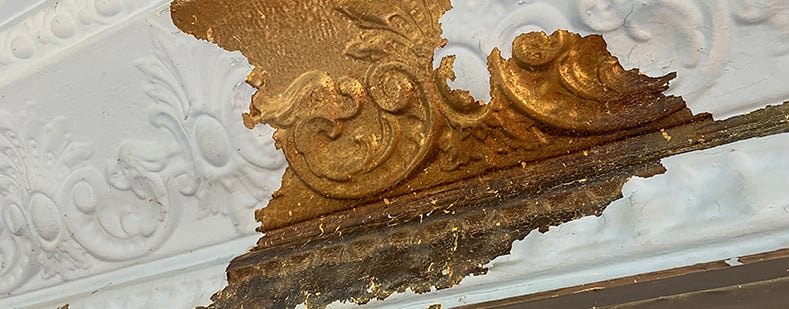Tin ceilings are a popular decorative element in buildings, particularly in older structures. However, restoring a tin ceiling requires careful consideration and attention to detail. These ceilings are typically constructed of thin, delicate metal and can be easily damaged accidentally. Contractors that specialize in restoration should be consulted prior to the beginning of a tin ceiling restoration project.
These pressed tiles are commonly encountered in historic buildings from the mid-19th to early 20th centuries, including hotels, theaters, churches, and commercial spaces. Now, many modern restaurants, bars, and cafes often incorporate tin ceilings into their interior design. While residential homes occasionally embrace tin ceilings, they are much more prevalent in areas undergoing restoration projects aimed to rehabilitate and repurpose older structures.
It is important to be cautious of lead paint that may be present on the tin. Many older buildings were coated with lead based paint, which can pose serious health risks if not handled properly. When disturbing older paint, local and state regulations should be followed to ensure proper handling and disposal.
The most common ways to remove paint from tin ceilings include:
-
Heat Guns and Scrapers:
Usually used in residential applications with smaller square footage projects, manually removing paint with a heat gun is a time consuming process. Heat guns can soften some coatings, making it easier to remove with a paint scraper. Care must be taken to not gouge the tin with the paint scraper. It's easy to slip and cause irreversible damage to the surface.
Special PPE must be used when heating up painted surfaces. Certain coatings such as lead based paints commonly release toxic fumes when heated up. Inhalation of paint fumes have obvious, negative consequences for one's health and should be avoided.
Additionally, it's important to know what is behind the tin as fires have been started using heat guns to remove paint. Many paints are combustable at high temperatures, making this method of paint removal very risky to the building itself.
-
Chemical Strippers and Peelers:
Chemical strippers and peelers can be effective at removing paint. It's important to always apply the stripper chemicals according to the manufacturer's instructions. If usage instructions are not followed carefully, the tin surface can be damaged. In most cases, the stripper product causes the paint to soften. When soft, the paint can be manually removed with hand tools. Other peeler products require sheets of plastic to peel off the stripper and take the old paint with it.
This is a long process that usually takes weeks or even months to remove layers of paint from the tin. Multiple applications of the chemical strippers should be expected, as the paint usually comes off in patches.
- Sponge Blasting:
Usually known as sponge cleaning when working to restore delicate surfaces, many restoration contractors use Sponge Media™ to remove old paint. Much faster than peelers and hand scraping, Sponge Blasting can remove old coatings from tin ceilings substantially faster - in some cases 10 to 15 times faster, shortening a weeks or months long process to just days.
If the tin ceiling's paint does contain lead, the Sponge-Jet process should be an easy choice. Lead abatement professionals have used Sponge Media to remove hundreds of thousands of square feet/meters of lead paint. Not only does Sponge Blasting limit worker exposure to lead dust, waste disposal costs are dramatically limited due to Sponge Media's recyclability. Less media used, means less waste to dispose of.
As is the case with all restoration processes, care must be taken to avoid damaging the tin. Sponge Blasting allows contractors to dial down the pressure, while skimming the surface with sponge. Warping is a common problem with tin ceiling restorations, but by reducing pressure with Sponge-Jet Feed Units, the warping risk is much lower.
The results can be seen in the video below:
Restoring a tin ceiling requires careful consideration and attention to detail. Be cautious of the presence of lead paint which can pose serious health risks if not handled properly. If you are considering restoring a tin ceiling in your building, be sure to consult with professionals and take the necessary steps to ensure a successful and safe restoration.








